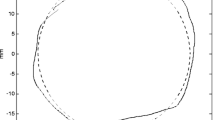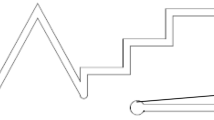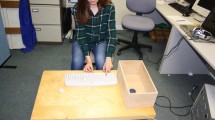Abstract
Background: In the study of psychomotor performance in anorexia nervosa (AN), motor control has not been studied extensively. The present study explores sequence planning in a sample of AN patients. Method: A group of 26 female restricting AN inpatients, aged 14 to 25, was compared with 24 healthy women matched for age and educational level. During the performance of a simple copying task, in which movement planning, but not working capacity, was challenged, the ease with which generally favored graphic production rules could be applied was manipulated. Computerized recordings of the drawing movements allowed detailed analyses of reaction and movement times and of drawing sequences. Fifteen patients were retested after weight restoration, as were 15 controls. Results: Copying patterns that normally elicit a conflict between preferred graphic production rules induced significantly less slowing in the reaction times of the anorexia nervosa patients than in the controls, both before and after weight restoration. There were no group differences as regards the consistency with which the implicit production rules were applied. Discussion: AN patients seem to show a fast response style combined with good sequence planning capacity.
Similar content being viewed by others
References
Keele S.: Motor control. In: Boff J.K., Kaufman L., Thomas J.P. (Eds.), Handbook of human perception and performance. Vol. II. New York, Wiley & Sons, 1986, pp. 1–60.
Rosenbaum D.A., Meulenbroek R.J., Vaughan J., Jansen C.: Posture-based motion planning: Applications to grasping. Psychol. Rev., 108, 709–734, 2001.
Rosenbaum D.A.: Cinderella after the ball. Am. Psychol., 61, 78–79, 2006.
Van Galen G.P., Thomassen A.J., Wing A.M.: Handwriting — A movement theme. Hum. Mov. Sci., 10, 163–164, 1991.
Willingham D.T.: A neuropsychological theory of motor skill learning. Psychol. Rev., 105, 558–584, 1998.
Willingham DT.: Cognition. The thinking animal. 2nd ed. Upper Saddle River, New Jersey, Pearson Prentice Hall, 2004.
Casper R.C.: The ‘drive for activity’ and “restlessness” in anorexia nervosa: Potential pathways. J. Affect. Disord., 92, 99–107, 2006.
Duchesne M., Mattos P., Fontenelle L.F., Veiga H., Rizo L., Appolinario J.C.: Neuropsychology of eating disorders: a systematic review of the literature. Rev. Bras. Psiquiatr., 26, 107–117, 2004.
Lauer C.J.: Neuropsychological findings in eating disorders. In: D’haenen H., den Boer J.A., Willner P. (Eds.), Biological psychiatry. New York, John Wiley & Sons, 2002, pp. 1167–1172.
Lena S.M., Fiocco A.J., Leyenaar J.K.: The role of cognitive deficits in the development of eating disorders. Neuropsychol. Rev., 14, 99–113, 2004.
Tchanturia K., Campbell I.C., Morris R.G., Treasure J.: Neuropsychological studies in anorexia nervosa. Int. J. Eat. Disord., 37, Suppl., S72–S76, 2005.
Bowers W.A.: Neuropsychological impairment among anorexia nervosa and bulimia patients. Eating Disorders: The Journal of Treatment and Prevention, 2, 42–46, 1994.
Fassino S., Piero A., Daga G.A., Leombruni P., Mortara P., Rovera G.G.: Attentional biases and frontal functioning in anorexia nervosa. Int. J. Eat. Disord., 31, 274–283, 2002.
Fox C.F.: Neuropsychological correlations of anorexia nervosa. Int. J. Psychiatry Med., 11, 285–290, 1981.
Jones B.P., Duncan C.C., Brouwers P., Mirsky A.F.: Cognition in eating disorders. J. Clin. Exp. Neuropsychol., 13, 711–728, 1991.
Lauer C.J., Gorzewski B., Gerlinghoff M., Backmund H., Zihl J.: Neuropsychological assessments before and after treatment in patients with anorexia nervosa and bulimia nervosa. J. Psychiatr. Res., 33, 129–138, 1999.
Lawrence A.D., Dowson J., Foxall G.L., Summerfield R., Robbins T.W., Sahakian B.J.: Impaired visual discrimination learning in anorexia nervosa. Appetite, 40, 85–89, 2003.
Tchanturia K., Morris R.G., Surguladze S., Treasure J.: An examination of perceptual and cognitive set shifting tasks in acute anorexia nervosa and following recovery. Eat. Weight Disord., 7, 312–315, 2002.
Tchanturia K., Anderluh M.B., Morris R.G., Rabe- Hesketh S., Collier D.A., Sanchez P., Treasure J.: Cognitive flexibility in anorexia nervosa and bulimia nervosa. J. Int. Neuropsychol. Soc., 10, 513–520, 2004.
Tchanturia K., Morris R.G., Anderluh M.B., Collier D.A,. Nikolaou V., Treasure J.: Set shifting in anorexia nervosa: an examination before and after weight gain, in full recovery and relationship to childhood and adult OCPD traits. J. Psychiatr. Res., 38, 545–552, 2004.
Kaye W.H., Bastiani A.M., Moss H.: Cognitive style of patients with anorexia nervosa and bulimia nervosa. Int. J. Eat. Dis., 18, 287–290, 1995.
Toner B.B., Garfinkel P.E., Garner D.M.: Cognitive style of patients with bulimic and diet-restricting anorexia nervosa. Am. J. Psychiatry, 144, 510–512, 1987.
Jones B.P., Duncan C.C., Brouwers P., Mirsky A.F.: Cognition in eating disorders. J. Clin. Exp. Neuropsychol., 13, 711–728, 1991.
Kingston K., Szmukler G., Andrewes D., Tress B., Desmond P.: Neuropsychological and structural brain changes in anorexia nervosa before and after refeeding. Psychol. Med., 26, 15–28 1996.
Mathias J.L., Kent P.S.: Neuropsychological consequences of extreme weight loss and dietary restriction in patients with anorexia nervosa. J. Clin. Exp. Neuropsychol., 20, 548–564, 1998.
Thompson S.B.: Implications of neuropsychological test results of women in a new phase of anorexia nervosa. Eur. Eat. Dis. Rev., 1, 152–165, 1993.
Cavedini P., Bassi T., Ubbiali A., Casolari A., Giordani S., Zorzi C., Bellodi L.: Neuropsychological investigation of decision-making in anorexia nervosa. Psychiatry Res., 127, 259–266, 2004.
Seed J.A., Dixon R.A., McCluskey S.E., Young A.H.: Basal activity of the hypothalamic-pituitary-adrenal axis and cognitive function in anorexia nervosa. Eur. Arch. Psychiatry Clin. Neurosci., 250, 11–15, 2000.
Green M.W., Elliman N.A., Wakeling A., Rogers P.J.: Cognitive functioning, weight change and therapy in anorexia nervosa. J. Psychiatr. Res., 30, 401–410 1996.
Szmukler G.I., Andrewes D., Kingston K., Chen L., Stargatt R., Stanley R.: Neuropsychological impairment in anorexia nervosa: before and after refeeding. J. Clin. Exp. Neuropsychol., 14, 347–352, 1992.
Hamsher K.S., Halmi K.A., Benton A.L.: Prediction of outcome in anorexia nervosa from neuropsychological status. Psychiatry Res., 4, 79–88, 1981.
Gillberg C., Rastam M., Gillberg I.C.: Anorexia nervosa: physical health and neurodevelopment at 16 and 21 years. Dev. Med. Child Neurol., 36, 567–575, 1994.
Holliday J., Tchanturia K., Landau S., Collier D., Treasure J.: Is impaired set-shifting an endophenotype of anorexia nervosa? Am. J. Psychiatry, 162, 2269–2275, 2005.
Wentz E., Gillberg I.C., Gillberg C., Rastam M.: Tenyear follow-up of adolescent-onset anorexia nervosa: physical health and neurodevelopment. Dev. Med. Child Neurol., 42, 328–333, 2000.
Murphy R., Nutzinger D.O., Paul T., Leplow B.: Dissociated conditional-associative learning in anorexia nervosa. J. Clin. Exp. Neuropsychol., 24, 176–186, 2002.
Witt E.D., Ryan C., Hsu L.K.: Learning deficits in adolescents with anorexia nervosa. J. Nerv. Ment. Dis., 173, 182–184, 1985.
Chiappelli F., Gwirtsman H.E., Lowy M., Gormley G., Nguyen L.D., Nguyen L., Popow J., Esmail I., Fahey J.L., Strober M.: Pituitary-adrenal-immune system in normal subjects and in patients with anorexia nervosa: the number of circulating helper T lymphocytes (CD4) expressing the homing receptor Leu8 is regulated in part by pituitary-adrenal products. Psychoneuroendocrinology, 16, 423–432, 1991.
McElroy S.L., Kotwal R., Keck P.E., Jr., Akiskal H.S.: Comorbidity of bipolar and eating disorders: distinct or related disorders with shared dysregulations? J. Affect. Disord., 86, 107–127, 2005.
Strober M., Katz J.: Do eating disorders and affective disorders share a common etiology? A dissenting opinion. Int. J. Eat. Disord., 6, 171–180, 1987.
Swift W.J., Andrews D., Barklage N.E.: The relationship between affective disorder and eating disorders: a review of the literature. Am. J. Psychiatry, 143, 290–299, 1986.
Szmukler G.: Some comments on the link between anorexia nervosa and affective disorder. Int. J. Eat. Disord., 6, 181–189, 1987.
Sabbe B., Hulstijn W., van Hoof J., Zitman F.: Fine motor retardation and depression. J. Psychiatr. Res., 30, 295–306, 1996.
Sabbe B., Hulstijn W., van Hoof J., Tuynman-Qua H.G., Zitman F.: Retardation in depression: assessment by means of simple motor tasks. J. Affect. Disord., 55, 39–44, 1999.
Pieters G., Sabbe B., Hulstijn W., Probst M., Vandereycken W., Peuskens J.: Fast psychomotor functioning in underweight anorexia nervosa patients. J. Psychiatr. Res., 37, 501–508, 2003.
Pieters G., Maas Y., Hulstijn W., Vandereycken W., Probst M., Peuskens J., Sabbe B.: Differentiation of cognitive and motor aspects in a digit symbol substitution test in Anorexia nervosa patients, before and after weight restoration. Psychopathology, 37, 227–232, 2004.
Pieters G., Hulstijn W., Vandereycken W., Maas Y., Probst M., Peuskens J., Sabbe B.: Fast psychomotor functioning in anorexia nervosa: effect of weight restoration. J. Clin. Exp. Neuropsychol., 27, 931–942, 2005.
Thomassen A., Tibosch H.: A quantative model of graphic production. In: Stelmach G.E., Requin J. (Eds.), Tutorials in Motor Neuroscience. Dordrecht, Kluwer, 1991, pp. 269–282.
Vinter A.: Hierarchy among graphic production rules: a developmental approach. In: Faure C., Keuss P., Lorette G., Vinter A. (Eds.), Advances in handwriting & drawing: a multidisciplinary approach. Paris, Europia, 1993, pp. 275–291.
Thomassen A., Van Galen G.P.: Handwriting as a motor task: experimentation, modelling, and simulation. In: Summers J.J. (Ed.), Approaches to the study of motor control and learning. Amsterdam, Elsevier Science Publishers, 1992, pp. 113–144.
Thomassen A., Meulenbroek R., Tibosch H.: Latencies and Kinematics Reflect Graphic Production Rules. Hum. Mov. Sci., 10, 271–289, 1991.
Jogems-Kosterman B., Hulstijn W., van Hoof J., Thomassen A.: Is the planning of action in schizophrenic patients more impaired than in depressed patients? The effects of conflicting graphic production rules. In: Leedham C.G., Leung M., Sagar V., Xuhong X. (Eds.), Proceedings of the 9th Biennial Conference of the International Graphonomics Society. Singapore, NTU, 1999, pp. 225–229.
Hulstijn W., Jogems-Kosterman B., Wezenberg E., Sabbe B.: An evaluation of the use of figure-copying tasks in studies of planning deficits in schizophrenia. In: Meulenbroek R.G., Steenbergen B. (Eds.), Proceedings of the 10th biennial conference of the International Graphonomics Society. Nijmegen, IGS, 2001, pp. 46–51.
Jogems-Kosterman B.J., Hulstijn W., Wezenberg E., van Hoof J.: Movement planning deficits in schizophrenia: failure to inhibit automatic response tendencies. Cognit. Neuropsychiatry, 11, 47–64, 2006.
Derogatis L.R.: SCL-90-R manual. Baltimore, Johns Hopkins University Press, 1977.
Beck A.T., Ward C.H., Mendelson M., Mock J., Erbaugh J.: An inventory for measuring depression. Arch. Gen. Psychiatry, 4, 561–571, 1961.
Garner D., Olmsted M., Polivy J.: Development and validation of a multidimensional eating disorder inventory for anorexia nervosa and bulimia. Int. J. Eat. Disord., 2, 15–34, 1983.
Vandereycken W.: The Eating Disorder Evaluation Scale (EDES). Eating Disorders: The Journal of Treatment and Prevention., 1, 115–122, 1993.
De Jong W.P., Hulstijn W., Kosterman B.J.M., Smits- Engelsman B.C.M.: OASIS software and its application in experimental handwriting research. In: Simner M.L., Leedham C.G., Thomassen, A.J.W.M. (Eds.), Handwriting and drawing research: Basic and applied issues. Amsterdam, IOS Press, 1996, pp. 429–440.
Kaye W.H., Frank G.K., Bailer U.F., Henry S.E.: Neurobiology of anorexia nervosa: clinical implications of alterations of the function of serotonin and other neuronal systems. Int. J. Eat. Disord., 37 Suppl, S15–S19, 2005.
Keilp J.G., Sackeim H.A., Mann J.J.: Correlates of trait impulsiveness in performance measures and neuropsychological tests. Psychiatry Res., 135, 191–201, 2005.
Strupp B.J., Weingartner H., Kaye W., Gwirtsman H.: Cognitive processing in anorexia nervosa. A disturbance in automatic information processing. Neuropsychobiology, 15, 89–94, 1986.
Southgate L., Tchanturia K., Treasure J.: Neuropsychological studies in eating disorders: a review. In: Swain P.I. (Ed.), Eating disorders: new research. Hauppauge, NY, Nova Science Publishers, 2005.
Author information
Authors and Affiliations
Corresponding author
Rights and permissions
About this article
Cite this article
Pieters, G., Hulstijn, W., Maas, Y. et al. Psychomotor performance and sequence planning in anorexia nervosa before and after weight restoration. Eat Weight Disord 11, 154–162 (2006). https://doi.org/10.1007/BF03327561
Received:
Accepted:
Published:
Issue Date:
DOI: https://doi.org/10.1007/BF03327561




